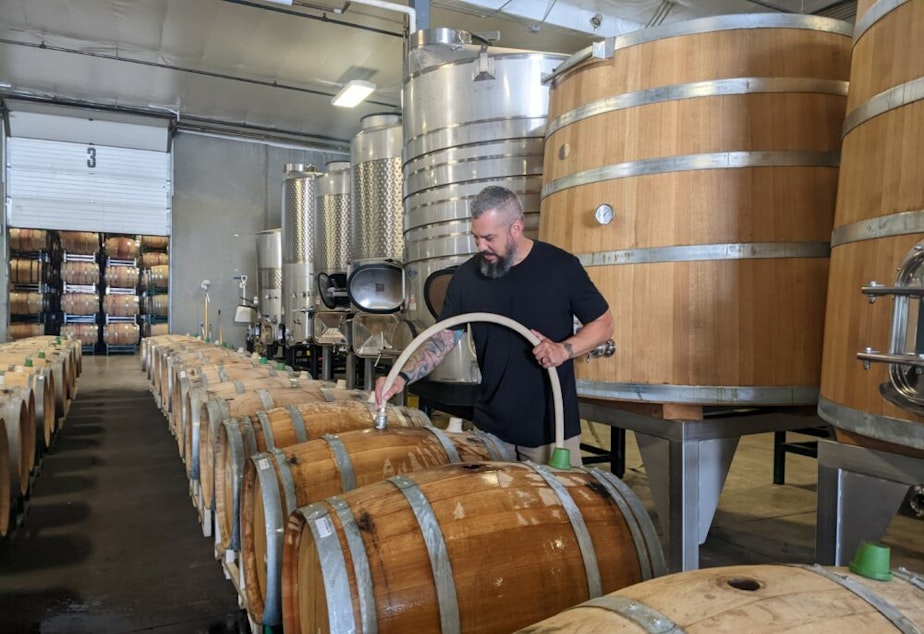In 2020, wildfires in the West have left the region’s grapes grown for wine with a grey and smoky flavor. This year, Washington is on track for a record harvest, but vintners are still finding the best way to deal with the effects of the smog.
“And we decided to pick a piece of Malbec today…”
This is harvest season in much of the West. But Washington’s wine grapes are late — about two weeks. “So we’re going to see how the picking is going.”
That’s Charlie Hopps. He owns the Fidelitas winery in Richland. We’re in the Red Mountain American Viticultural Area overlooking over 2,000 acres of vineyard vines and grapes that are ready — or nearly ready — for harvest.

Growers like Hopps face many challenges this season — record-breaking heat, light rain — and smoke from nearby wildfires. The smoke seeps into the fruit, giving the wines produced from them an ash and smoky flavor. While it hasn’t been that bad this year, wildfires in 2020 have swept across states across the West. “We had a week in September where we didn’t see the sun. That’s always been a problem,” Hopps said. “You know, WSU and Tom Collins are here to help us sort this out.”
In his office at the WSU Center for Wine Science, Professor Tom Collins is preparing for his next winemaking class. He has been studying how smoke exposure affects grapes for years and has just submitted the team’s latest findings to the journal Nature.
Seventeen researchers between UC Davis, Oregon State University and WSU are working on the problem of smoke-exposed wine grapes. Collins said he worked closely with the Oregon State University lab to test these smoke-causing compounds.
“In a nutshell, what the first paper is going to say is that we’ve identified this class of compounds, and we think we know how they got there,” Collins said.
If you know what causes smoky flavors, he says scientists can study how to remove them from wine.
Back at the Fidelitas winery, oenologist Rebecca Albert had to do a lot of work to mitigate the damage to the 2020 vintage. But removing smoke compounds is a delicate balancing act.
“So you’re tasting wine and juice as well, well, I can use this yeast on it. Well, the sugar is really high. So the alcohol will be high, and I can’t use this. So there’s more Similar decisions need to be made based on numbers, but also on taste,” Albert said.
Making a blend of different grape types is one way winemakers are saving the 2020 harvest. Fidelitas winemaker Mitch Venohr is pleased that researchers have come a long way in identifying smoke compounds – but…
“The next big question now is, how do we specifically remove these substances from the wine? Or what can be done in the vineyard to prevent these smoke compounds from entering the grapes?”

Tom Collins has some thoughts on this, too.
Most of us are familiar with the Air-Now-dot-gov website for checking air quality during wildfire season. Many of these sensors are in towns and cities to assess risks to human health, he said.
“Because of terrain differences and wind direction, we thought it was important to have sensor networks where there was agriculture,” Collins said.
Sensors monitor weather conditions, the location of wildfires, and predict where smoke may end up. This can help growers better prepare and decide when to harvest wine grapes.
Nearly 100 sensors are spread across vineyards in California, Oregon and Washington. “So in Yakima Valley, Lake Chelan, Varuk Slope, Royal Slope, Walla Walla Mountains up and down — we’re hitting all the major growing areas, we’re going to have some dips in the Columbia Gorge by the end of the season, ‘ Collins said.
The goal, he said, is to get as many people as possible to investigate the question – and come up with the answers that the industry – and wine lovers – are looking for.
Produced with assistance from the editorial staff of the Association of Public Media Journalists, funded by the private company Public Broadcasting Corporation of the American People.
